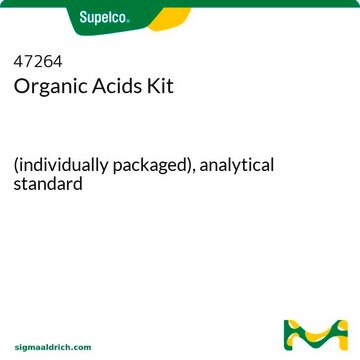MAK184
Succinate Colorimetric Assay Kit
Sufficient for 100 Colorimetric tests
Synonym(s):
Succinic Acid Assay Kit
Sign Into View Organizational & Contract Pricing
All Photos(2)
About This Item
Recommended Products
application(s)
cosmetics
food and beverages
detection method
colorimetric
relevant disease(s)
cardiovascular diseases; immunological diseases
storage temp.
−20°C
General description
Succinate (succinic acid) is a citric acid cycle intermediate and functions in the transport of electrons to the mitochondrial electron transport chain. It also functions in innate immune signaling and induces IL-1β production during inflammation. Succinates have been often used for the treatment of hypertension. Succinate measurements can be useful for studying its metabolic, immunological, and therapeutic activities.
Application
Succinate Colorimetric Assay Kit has been used to measure the concentration of succinate.
Suitability
Suitable for the detection of succinate in a variety of samples such as cell and tissue culture supernatants and in liquid samples such as wine.
Principle
The Succinate Colorimetric Assay Kit is a highly sensitive assay for determining succinate levels (ranging from 2-10 nmole/well) in a variety of samples. Succinate concentration is determined by a coupled enzyme reaction, which results in a colorimetric (450 nm) product proportional to the succinate present.
Kit Components Only
Product No.
Description
- Succinate Assay Buffer
- Succinate Converter
- Succinate Enzyme Mix
- Succinate Substrate Mix
- Succinate Developer
- Succinate Standard
Signal Word
Danger
Hazard Statements
Precautionary Statements
Hazard Classifications
Eye Dam. 1 - Resp. Sens. 1 - Skin Corr. 1B
Storage Class Code
8A - Combustible corrosive hazardous materials
Certificates of Analysis (COA)
Search for Certificates of Analysis (COA) by entering the products Lot/Batch Number. Lot and Batch Numbers can be found on a product’s label following the words ‘Lot’ or ‘Batch’.
Already Own This Product?
Find documentation for the products that you have recently purchased in the Document Library.
DNA methyltransferase 3b regulates articular cartilage homeostasis by altering metabolism.
Shen J, et al.
JCI insight, 2(12) (2017)
VSIG4 inhibits proinflammatory macrophage activation by reprogramming mitochondrial pyruvate metabolism.
Li J, et al.
Nature Communications, 8(1), 1322-1322 (2017)
Metoprolol succinate extended release/hydrochlorothiazide combination tablets.
Hainer JW and Jennifer S
Vascular Health, 3(3), 279-279 (2007)
Electron Transport and Oxidative Phosphorylation
Lodish H, et al.
Molecular Cell Biology (2000)
Mengdi Zhang et al.
Cell death discovery, 8(1), 138-138 (2022-03-31)
Hypoxia causes neonatal neuronal damage. However, the underlying mechanism remains unclear. This study aimed to explore the changes in succinate levels and identify the mechanisms underlying their contribution to hypoxia-induced damage in newborn mice. The neonatal C57BL/6J mouse hypoxia model
Our team of scientists has experience in all areas of research including Life Science, Material Science, Chemical Synthesis, Chromatography, Analytical and many others.
Contact Technical Service



